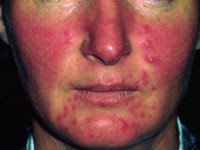 A new study at the Stanford University School of Medicine, have found a genetic basis for rosacea, an incurable and poorly understood skin disease. Treatment options for rosacea now are limited, but finding out what causes the disease could help scientists identify new targets for treatment and understand its links to other known diseases.
A new study at the Stanford University School of Medicine, have found a genetic basis for rosacea, an incurable and poorly understood skin disease. Treatment options for rosacea now are limited, but finding out what causes the disease could help scientists identify new targets for treatment and understand its links to other known diseases.
The study’s findings was published in the Journal of Investigative Dermatology. Rosacea causes skin on the face to redden and can result in acne like bumps. “Rosacea is a very visible, inflammatory disease of the skin,” said Anne Lynn Chang, MD, lead author of the paper and an assistant professor of dermatology at Stanford. “It can lead to permanent scarring.”
According to the National Rosacea Society, the disease affects around 14 million Americans, or 5 percent of the population. In northern European countries, the prevalence is greater, at around 10 percent of the population. Rosacea is most visible in fair-skinned people but affects people of all skin types.
“It is one of the most common things we see in dermatology clinics that is incurable and not easily treatable,” Chang said.
Rosacea patients can also experience red itching skin, stinging and burning sensations on the affected skin. This can make sleeping and social interactions difficult. Other research suggests the disease could be associated with underlying systemic diseases that affect other organ systems in addition to the skin.
Chang and her collaborators look for the genetic basis of rosacea. The scientists ran two separate experiments to help ensure the results were consistent. The first experiment had 2,618 rosacea patients, and the second had 3,205 rosacea patients.
The researchers compared the genomes of rosacea patients and controls and looked for differences in the DNA building blocks, called nucleotides, in people diagnosed with rosacea. Such differences, called single nucleotide polymorphisms, occur when one nucleotide, such as guanine, is substituted for another, such as cytosine. This kind of analysis is called a genome-wide association and, because the entire genome is searched, is an unbiased way to look for genetic links to disease.
Only two areas of the genome were associated with having rosacea, and these two areas were located near genes known for their role in inflammatory and autoimmune diseases such as multiple sclerosis, diabetes, sarcoidosis and inflammatory bowel disease. Single nucleotide polymorphisms located near genes can play a role in regulating that gene — for example, regulating
whether the gene is expressed. Chang described the study as a forward-looking examination of the genetic associations of rosacea. “The next step is to look more into these associations of rosacea with other diseases,” Chang said, “and explore whether the inflammation in rosacea is a cutaneous sign of risk for other disease.”
Researchers agree that the best way to treat rosacea is with good skin health.
[aio_button align=”none” animation=”shake” color=”red” size=”small” icon=”none” text=”Learn More” relationship=”dofollow” url=”http://www.fenvir.com/”] [aio_button align=”none” animation=”shake” color=”gray” size=”small” icon=”none” text=”Buy Now” relationship=”dofollow” url=”http://www.fenvir.com/order-now”]

